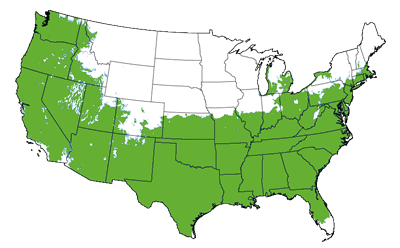Tuscarora Crape Myrtle
Product Details
 Growing Zones 6-9
Growing Zones 6-9
| Soil Type | Adaptable |
| Sunlight | Full |
| Drought Tolerance | Good |
| Mature Height | 20-30 Feet |
| Mature Width | 15-20 Feet |
| Growth Rate | fast |
| Bloom Color | Pink |
| Shipping Restriction | AZ, OR |
You will be the envy of the neighborhood with this lovely, vase-shaped Crape Myrtle. The Tuscarora explodes with loads of pink blooms all summer long.
It is hard to beat the classic and stunning Crape Myrtle shape, the bloom color, the adaptability, and the ease of care of the Tuscarora Crape Myrtle. This tree is as hardy as it is attractive!
Whether planted alone as a focal point or in a group as a cluster planting or along a border, the Tuscarora really stands out! If you are looking to add some vibrant and unique color to an otherwise plain landscape the Tuscarora Crape Myrtle is a great choice.
Aside from its beauty the Tuscarora Crape is ideal for those seeking a low maintenance, no fuss trees. It is disease and pest resistant as well as drought tolerant. The Tuscarora is a fast grower, easily growing 3 ft per year. At maturity this tree can reach up to 25 ft tall and 20 ft wide.
Crape Myrtle Tree Comparisons
Be sure you choose the right location and have the appropriate conditions for your new Tuscarora Crape Myrtle to thrive. Luckily Crape Myrtles are pretty easy to grow and don't require much maintenance at all. If you follow growing zone guidelines for your particular variety you can plant your crape myrtle just about any time of year. Tuscarora Crape Myrtles grow in zones 7-11.
These trees prefer full sun, but can tolerate some shade and are adaptable to just about any soil as long as it is well-draining. Crape Myrtles do enjoy a slightly acidic soil with a pH range of 5.0 or 6.5 being ideal, but as long as your soil isn't extremely alkaline there is no need to modify it. Mulching with a 2-3 inch layer of pine straw or pine bark is ideal for crape myrtles. Do not allow the mulch to touch the trunk as these increases the chances of pests and disease. Mulching helps keep soil moist and protects roots during temperature extremes. Crape Myrtles should be watered deeply about 2 times per week after planting for about 3 months. After this establishment period, water deeply about once weekly when conditions are dry. Crape Myrtles are drought tolerant once established. Fertilize in early spring and when planting to give your tree a boost and help it achieve the best blooms. Choose a balanced, slow release fertilizer. If you know your soil is on the basic side choose a fertilizer that is for acid loving plants. Crape Myrtles do not generally require pruning, but if needed, prune when they are dormant to remove any dead, dying, or crowded branches. Avoid the need to over prune your tree by choosing a variety that fits best in your chosen spot. You can choose a variety that is only 5 feet tall up to varieties that grow over 30 feet tall. Tuscarora Crape Myrtles grow up to 25 feet tall and 20 feet wide.
The best way to prevent disease and pests is by providing the appropriate care for your plants. Proper location choice, watering and fertilization are the keys to your success. There are not many pests or diseases that cause severe problems for crape myrtles. Aphids are one of the few pests that attack crape myrtles. Minor infections aren't likely to cause problems, but a severe infection can weaken your tree. You can treat aphids naturally with horticultural oil, neem oil, or insecticidal soap. For severe infections use pesticides like carbaryl, also known as Sevin. The Tuscarora crape myrtle is resistant to Powdery Mildew.
The Tuscarora Crape Myrtle will look great anywhere in your landscape. The pink blooms give a soft, yet vibrant look to your yard. It can reach about 30 feet tall and 20 feet wide so be mindful of this when choosing a spot to plant your tree. Crape Myrtles look great as single specimens planted in your yard and provide a wonderful focal point. Tuscarora Crape Myrtles will also look great framing your front door or the front entrance of your driveway. Plant 1 on each side and watch them grow into magnificent flowering trees.
Learn when to prune your flowering shrubs.
For additional Crape Myrtle options, be sure to check out our Crape Myrtle collections, Crape Myrtles, Flowering trees and Black Diamond Crape Myrtles









